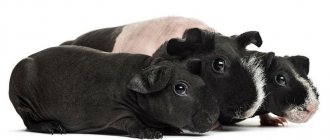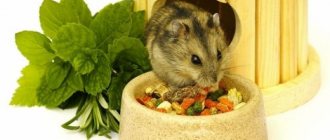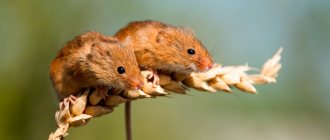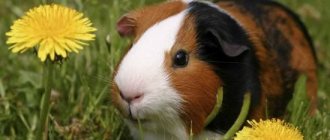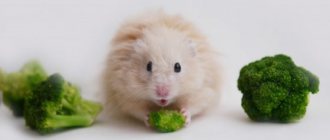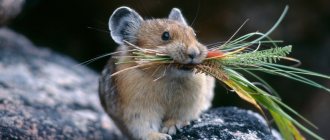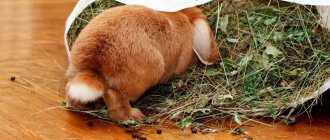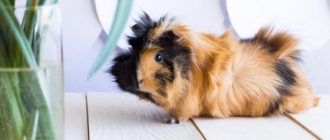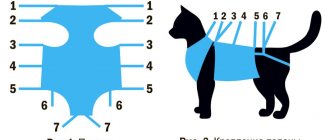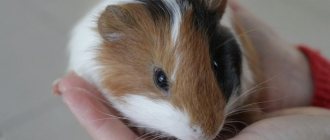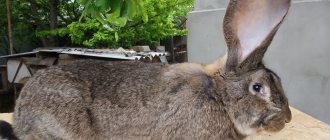How to set up a cage for a guinea pig?
It is not enough to make a cage, you need to equip it, creating comfortable conditions for existence for the animal. Here's what a pet might need in a pen:
- Bed
. Many people are interested in whether a guinea pig needs a house in a cage. Experts say it is needed. Here the animal can take a break from human attention. It can be made from the same plywood or sewn into a soft sleeping bag. - Drinker and feeder
. There is no need to explain why these elements are in the cage. - Hay tray
. Guinea pigs are constantly chewing on something, and they especially love fresh grass. It is better to design a special compartment for them so that the hay does not lie all over the cage. - Ladder
. It is necessary if the cage has several floors. - Toys
. Pigs especially love products like a hole or a labyrinth. You can use for this purpose a piece of ordinary plastic pipe with a diameter corresponding to the size of the animal. - Hanging accessories
- hammocks and metal balls filled with hay or vegetables and fruits.
https://youtube.com/watch?v=NV-VbfnTiV4%250D
Guinea pig bedding in a cage
Animals need a warm and comfortable covering. There are several options for checkered bedding that are especially popular:
- Rug for a guinea pig in a cage, made of polyvinyl chloride (PVC)
. Such products are sold in large rolls, which makes it easier to manufacture the desired bedding. It is easy to care for such a rug, because you just need to shake it out, wipe it with a wet cloth and you can put it back in place. It is recommended to machine wash it once a week. - Fleece liner
. This fabric is well known to parents of small children. It is soft, warm and pleasant to the body. Fleece is waterproof, and sawdust and small debris can easily get stuck in this fabric. However, if you take care of the litter and wash it often, it looks aesthetically pleasing. - Bedding made from disposable diapers
. These are sold at pharmacies or pet stores and can be used as a rug. The only condition is that they need to be changed in a timely manner.
Guinea pig cage litter
Rodent owners use a variety of fillers:
- Sawdust
. This is a lightweight, soft and environmentally friendly material that is chosen by many. This filler should not contain too rough or sharp wood chips. - Wood pellets
. Arranging a cage for a guinea pig can be done using this filler. It absorbs moisture and odors well and emits a pleasant pine aroma. It can be covered with a PVC mat and thereby obtain a thick and warm bedding. - Plain paper or newspaper
. Cheap option that requires frequent replacement. - Corn granules
. They are harmless to guinea pigs, do not cause allergic reactions and smell good, but animals can eat them, so this type of litter also needs to be covered with a rug. - Wood shavings
. It must be well dried and free of resin, otherwise the animal may be poisoned by toxins, especially if a closed guinea pig cage is used.
Guinea pig toys in a cage
There are also a lot of options here, because there are so many breeders, so many ideas.
Those interested in how to equip a cage for a guinea pig and what to offer for leisure activities should pay attention to:
- Paper bags
. Pigs happily climb inside, chew on the walls and play with these objects. - Cardboard roll from toilet paper or towels
. Depending on their size, pets can climb inside and hide there, playing with each other. - Bricks and stones
. Necessary for sharpening claws and teeth. - Old socks stuffed with straws
. Pigs can use them as a pillow. - A towel fixed on the bars
. This improvised hammock will be loved by many pets.
Explanations for the table
The table itself is a little lower.
The column “sometimes and a little” means that these products can be fed to guinea pigs only as a treat - give them once every couple of days, in portions of no more than 15 g (if a little more, then that’s okay, but don’t get carried away). Everything should be clear with the “possible” and “not allowed” columns. You should not feed prohibited foods, even as an experiment, if you do not want to kill your pet.
All products must be fresh (except hay, of course). If there are even slight doubts about the quality, it is better not to feed such food. Buy food from suppliers whose products you are confident in. For example, the amount of pesticides that may be contained in an apple is safe for humans, but will cause serious consequences in a small rodent.
Products must be environmentally friendly.
What are the consequences of violating the nutritional rules?
According to statistics, pigs most often die due to intestinal disorders. With improper feeding, the microbial balance in the digestive tube is disrupted, the breakdown of cellulose is difficult, food is not properly digested, and death occurs from intoxication with metabolic products
This is why it is so important to monitor your diet and feeding regimen.
Feed must be of good quality and fresh, it must smell good and have no signs of spoilage or mold damage.
It is important that products are stored in places inaccessible to insects and wild rodents - carriers of dangerous diseases
How to choose food
Most rodent foods are simply not suitable for guinea pigs - they are full of grains and have nothing healthy for your pet. Of course, the animal will not object and will eat what it is fed. But this is not an indicator of usefulness - problems in the form of obesity and disturbances in the gastrointestinal tract will occur later.
Nevertheless, it is possible to provide high-quality food, and many veterinarians and breeders claim that it is even necessary. The best specialized food for guinea pigs is not cheap, but the cost of succulent food (which should be varied) in winter can even exceed this amount - feeding exclusively vegetables is also expensive.
The composition of the mixture granules should be close to what cavy like to eat in nature. They like dried herbs and vegetables, but there should be a minimum (or better yet, no) dried fruits. It is ideal if the manufacturer adds vitamins and minerals to the food for guinea pigs. The presence of vitamin C is especially important (if it is present in the mixture, additional vitamin C is not necessary).
You can prepare “compound feed” for guinea pigs yourself. What cereals can you feed these animals? Oats and barley are allowed, and to a lesser extent corn. Add some legumes (such as chickpeas or peas) to the mixture.
Below is an interesting video idea on how to prepare dry grass food with your own hands.
Guinea pig nutrition: general rules and recommendations
Your pet's daily menu should be balanced and varied.
It is very important to choose fresh and natural foods for feeding, which contain large amounts of essential vitamins and substances beneficial to the animal’s body.
You can purchase food for your animal both in veterinary stores and in regular supermarkets, choosing vegetables, herbs and fruits grown without the use of large amounts of chemicals and pesticides. In the summer, you can collect succulent grass yourself in the forest, in places remote from roads.
Important. A guinea pig needs to be fed at least 2 times a day. If a pet remains hungry for 18 hours or more, its health can be greatly undermined, and even death is possible.
If a pet remains hungry for 18 hours or more, its health can be greatly undermined, and even death is possible.
Compliance
One of the main rules in feeding a pet, which should be strictly adhered to from the first days of the animal’s appearance in the house, is the prohibition of overfeeding.
Overfeeding leads to overweight and obesity, which, in turn, negatively affects the health of the animal's heart and liver.
Important. Clean water, as well as grass, hay or grain, must be present in the pet’s cage at all times.
Mode
It is recommended to give food to the animal at the same time, thus establishing a feeding schedule. Standard feeding is recommended in the morning, afternoon and evening.
Change of feed
A radical change in food is quite stressful for the animal, which can harm its health. If there is a need to change food, it is best to do this in stages, gradually adding some new food to the usual main product.
New products
When introducing new, unusual foods into the animal’s diet, you should very carefully monitor the pet’s condition. The first portions of new food should be minimal.
If the animal begins to have any reactions, including with stool, the new product must be completely excluded from the diet.
Guinea pigs should only be given fresh food.
Food quality
Much attention should be paid to the quality of the food served: fresh vegetables, herbs, fruits and berries must be ripe and juicy. Before giving such food to an animal, the product must be thoroughly washed with running water. If the animal is given ready-made food, it is necessary to check the expiration date and store it in accordance with the instructions on the packaging
If your pet is given prepared food, check the expiration date and store it according to the directions on the packaging.
Important. It is strictly forbidden to give rotten, spoiled or moldy food to your pet.
Availability of water
Despite the fact that the animal receives a large amount of moisture from juicy, ripe vegetables, a drinking bowl with clean water should always be available. In the summer, your pet may need more water than in the winter.
Important. Water for the animal should be bottled
Cleanliness of dishes
The pet's home, as well as its dishes, must always be kept clean.
The water in the drinking bowl should be changed regularly, and the drinking bowl itself should be cleaned using a special brush. The same applies to all bowls and plates with food, especially dishes on which fresh vegetable or fruit food is served.
Dishes must be washed thoroughly without using dishwashing liquids. If necessary, plates and bowls can be washed with water and regular baking soda.
The bowls themselves can be ceramic or plastic.
Green feed
Green food consists of lush field or meadow grass: sage, chamomile, burdock, plantain, clover, etc. This product is a particularly important element in the diet of a guinea pig, so it is necessary to provide the animal with fresh herbs all year round. Spinach leaves or dill stalks are perfect.
Hay and branches
Hay and branches are so-called roughage or dry food, which helps maintain your pet's digestion and also wear down teeth.
The hay must be fresh and clean, free from foreign impurities and dust. Twigs for guinea pigs can be taken from willow, birch, linden, rowan, alder, pear or apple.
Important. It is forbidden to give the animal citrus and coniferous branches, as well as branches from trees whose fruits have hard seeds: peach, apricot, cherry, sweet cherry, plum, etc. On average, pigs eat 2-3 times a day.
On average, pigs eat 2-3 times a day.
Read with this
Feeding regimen and technique
Healthy adult guinea pigs are fed twice a day, while pregnant guinea pigs and babies are fed up to four times a day. With two meals a day, rodents are offered succulent food for “breakfast,” and grain or a grain mixture and greens are prepared for “dinner.” In winter, greens are replaced (or supplemented) with hay.
It may be an unpleasant surprise for first-time owners to learn that pigs (even piglets!) eat their own feces. But this is how nature has established it: it is in this unusual way that colonies of beneficial bacteria enter the pig’s body. If you do not allow your pet and her cubs to eat your litter, this will immediately have a negative impact on the health of the animals.
The principles of proper feeding of guinea pigs are:
- Gradual change in diet. Violation of this principle can lead to disruption of the animal’s digestive system.
- Compliance with feeding hygiene rules. These rules include removing food residues, regularly washing the feeder and drinking bowl, and washing vegetables, fruits, and leaves.
- A hearty dinner is required.
- The presence in the diet of a sufficient amount of vitamin C, which the animal’s body cannot synthesize. A lack of this vitamin can cause paralysis in rodents! For an adult, the norm of vitamin C per day is 15 mg per 1 kg of body weight. When pregnancy occurs, this rate doubles.
Daily ration
Once the owner decides what to feed the guinea pig, he should pay attention to feeding standards.
Here is an approximate daily diet for an adult from the pig family:
| Menu Component | Summer | Autumn | Winter | Spring |
| Fresh greens | 0.040 kg | 0.030 kg | ||
| Hay | 0.010 kg | 0.010 kg | ||
| Raw vegetables | 0.120 kg | 0.120 kg | 0.125 kg | 0.125 kg |
| White bread | 0.020 kg | 0.020 kg | 0.030 kg | 0.025 kg |
| Hard food | 0.040 kg | 0.040 kg | 0.040 kg | 0.040 kg |
Some veterinarians recommend feeding guinea pigs milk in the amount of 0.025 liters per day, regardless of season and age. Let us beg to differ with them. Rodents should not be accustomed to milk, because nature has not provided their body with enzymes that help digest dairy products.
You should be careful about your pet, because the given nutritional standards may vary depending on:
- degree of animal activity;
- health conditions;
- age.
So, pregnant females need more food. Therefore, the volume of food eaten for them increases by 30%.
Sorry, there are no surveys available at this time.
Vegetable menu
The main task of vitamin C in the rodent body is to control the functioning of connective and bone tissues. Animals have to look for it from external sources, since the animal body is not able to produce it in such quantities.
Pigs' favorites on the menu most often include apples, carrots and cucumbers. Vitamin C can enter the animal’s body through raw food of plant origin.
It is important to give them to your pet at least 1 teaspoon per day
Veterinarians also list the following as approved products:
- Zucchini is allowed due to its high content of minerals and pectins, which normalize the functioning of intestinal permeability.
- Carrots have a positive effect on the condition of the animal’s coat and skin, as well as visual and auditory function. You can give not only the fruit itself, but also well-washed tops. Due to the content of Vitamin A, urine may turn orange.
- Bell pepper can be given to animals only during the season, due to the fact that winter varieties are oversaturated with nitrates. Only sweet varieties are allowed to serve as food.
- Pumpkin is also given to the animal almost completely. And zinc contained in the seeds is a strong preventative against helminthiases.
- Cucumbers themselves are low in calories, safe and have the ability to help digest heavy fats.
- Fresh peas are also acceptable, but in small quantities. Despite the disapproval of veterinarians. Some food manufacturers add the essence of the fruit to their mixtures, despite the fact that they can cause a negative side reaction in the animal.
- Cabbage is also allowed, but subject to proper supervision. While it causes gas in some people, excessive use can be dangerous for pigs. It is worth introducing it into the diet gradually, observing the reaction of your friend.
- Rutabaga facilitates bowel movements and helps avoid constipation. Best suited for your pet's winter diet.
- Jerusalem artichoke can be given as a treat, strictly limiting its total amount in the animal’s diet. The root vegetable itself is the most dangerous; other parts of the plant can be given constantly.
The most undesirable products include:
- Tomatoes are especially considered dangerous when green. They contain solanine, in addition, the use of tops is also not recommended. Ripe tomatoes, due to the destruction of poisons, can be included in the diet in small quantities. If you overdo it, the animal may experience intestinal upset and problems with the gastrointestinal tract.
- Potatoes are prohibited due to starch and solanine.
- Melon has a risk of developing diabetes due to the abundance of sugars.
- Radish and radish oils can cause bloating.
- Beetroot has a stable effect and is not particularly recommended for pregnant females. Root vegetables and tops are recommended for healthy individuals in small quantities. After eating beets, the animal’s urine may temporarily acquire a red tint.
- Corn is prohibited for pigs; only tops are allowed. And grains contain a large amount of starch, which can cause obesity.
What fruits can you give to pets?
Fruits are also part of your furry friend's diet. While they're delicious and full of vitamins and minerals, they're also high in sugar, so don't overindulge on them. In the table below you will find the most common fruits that can sometimes be given to guinea pigs.
| Type of fruit | Examples |
| Berries. Despite the fact that not all fruits that we call berries are berries in the biological sense of the word, they are all safe for pigs. | strawberry; blueberry; elder; cranberry; blackberry. |
| Melons. They are completely safe and pets love them very much. | cassaba; melon; watermelon. |
| Tropical fruits. There are many of them and they are widely available in online stores. Edible, but you need to focus on your pet’s individual preferences. | mango; papaya; pineapples; bananas; figs |
| Stone fruits. Edible. But remember that pigs come from South America and the assortment of our stores will not be genetically familiar to them. | peaches; apricots; plums; nectarines; cherries. |
| Citrus. They are an excellent source of vitamin C and are highly preferred. | oranges; tangerines; grapefruits; clementines. |
Do not give your pet fruit seeds. Some drupes contain cyanide, which is life-threatening.
DIET
The nutritional characteristics of guinea pigs directly depend on the structure of the digestive system; due to the animal’s rather long intestines (2 m), the digestive process is also quite long. The movement of food is slow, processing time can reach a week, for this reason, food replacement should be done gradually.
A balanced diet is very important; food should have a gentle effect on the microflora. This condition is considered the most important point to ensure optimal well-being of the pet.
The frequency of feeding in accordance with the schedule is 2-3 times a day; violation of the schedule can lead to gastrointestinal dysfunction. The pig's feeder should never be empty; this must be constantly monitored.
We tell you how to teach a budgie to talk, and how to choose a suitable parrot for this.
If you are just starting to breed rabbits, here we describe how to do it correctly and how to set up a cage.
Read about how long decorative rats live and what they need to live here.
Requirements for dry food
Many pet stores sell a large variety of dry food mixtures that can be used for your guinea pig. However, the extensive range can cause confusion for many novice breeders of these rodents. For this reason, in order to choose the right dry food, you should pay attention to the following recommendations:
- You should not use mixtures every day that contain an increased level of fatty components (seeds, nuts), cellulose, sugar, or animal proteins;
- You can use food without dyes. Animals don't pay attention to different colors anyway;
- the composition of the feed should be balanced, cereals should predominate in it;
- the content of coarse fibers and vegetable proteins should be about 20%;
- Ascorbic acid (vitamin C) must be present in the composition.
If you wish, you can make your own dry food mixture; it’s quite simple. The composition must contain the following components:
- cereals;
- seeds;
- corn;
- legumes;
- dried fruits;
- dried vegetables;
- herbs.
Green food
This food must be given to your guinea pig, but you need to know what kind of greens you need to give your pet. The main herb is fresh grass from fields and meadows with medicinal and spicy herbs. You shouldn’t tear up greenery at the edge of the road, as many cars pass by and exhaust gases settle on the grass. It is not recommended to collect grass under trees either; birds like to sit on trees, and their droppings cause rotting of the greenery. Pigs love grass, it helps them always stay healthy. Greens contain many vitamins. Greenery includes not only field grass, but also that which a person eats. These animals love to eat: spinach, the stem and greens of dill, parsley, it’s worth giving a little, and lettuce and other greens.
Additional sources of vitamins and minerals
A natural source of vitamins for guinea pigs is grass. But since an animal living at home eats store-bought foods, additional additives are introduced into its diet:
- The most important of all vitamins for a guinea pig is vitamin C. The animal’s body cannot synthesize it on its own, so it is necessary to give 5-25 mg of ascorbic acid per day.
- Vitamins B and K are no less important for guinea pigs. It is not necessary to buy complexes with these substances. Her body does not absorb them immediately, but upon repeated passage through the intestinal tract. That's why she eats her feces.
- In addition to vitamins, a guinea pig needs salt. The average daily amount of this component is about 5 g.
How many times a day should you feed your guinea pig?
She is fed two to three times, provided that hay, as well as bowls of food and water, are constantly present in the cage. If the pig does not immediately try the fresh portion, it will definitely finish it after some time.
Juicy food is given, as a rule, in the first half of the day, and in the second half the emphasis shifts to dry food. With three meals a day, the rodent is given 1/3 tablespoon of dry food at one time, with two meals a day - half a tablespoon.
Having eaten the main provisions, the pig switches to dry grass: not only can it not starve, but it should not. An empty stomach causes intestinal stagnation.
Water
Having a fresh portion of drink in your pet's cage is a must. 250 ml is enough for one animal. Pregnant females require more fluid.
It is wrong to use boiled water. Filtered or bottled water will do. The cleanliness of the drink must be carefully monitored, since an infection can enter the animal’s body along with garbage.
It is recommended to use an automatic waterer, which will be a constant source of water for the pigs. With such a drinker, the water will be protected from contamination and spillage.
Rules for feeding guinea pigs:
- It is recommended to feed at the same time, which the animals quickly get used to.
- There is no need to give too much food, and it is better to remove uneaten leftover food from the cage (except for hay).
- Green food, vegetables and fruits must be fresh.
- Hay and/or grass should be available to pigs at all times.
- Fruits and vegetables should be thoroughly washed, but not peeled. It is better to peel sweet peppers, as the skin is difficult to chew.
- Lettuce leaves absorb harmful substances, so it is recommended to rinse them thoroughly and dry them.
- The water in drinking bowls must be changed daily.
- From time to time you can give your pigs something to chew on.
Catering
To understand what to feed a guinea pig at home, you need to familiarize yourself with the physiological characteristics of this rodent. His body is structured differently from that of a human. The main difference is that intestinal motility in a rodent is much weaker than in humans. Accordingly, most foods that are palatable to humans simply cannot be given to rodents.
To properly feed your furry friend, think about what he eats in the wild. The diet of a domesticated rodent should not differ radically from the diet of a rodent that lives in the wild. And in the wild it feeds on various plants, grains, hay, roots, and some fruits and vegetables.
When preparing a diet for your pet, you should take into account the individual characteristics of the animals, each of which has its own preferences. Some rodents love apples, while others prefer carrots, some like succulent food, and others like hay. This does not mean that you need to feed your pet only the foods that he likes. The diet should be well thought out and balanced. But, if possible, give preference to those products that the rodent likes. Also take into account that along with his favorite food, it is advisable to feed your ward food that he does not like, but which should be present in the diet.
You cannot leave food for future use by rodents. If you are going on a two or three day business trip, take your pet to a friend or give it to a foster home. If you give your pet to friends, instruct them on what you can and cannot feed the rodent.
Diet
Before moving directly to the description of permitted and prohibited foods, let’s make a reservation about how many times a day to feed a guinea pig. Rodents need to be fed often, but little by little. It is advisable to fill your pet's feeders 4 times a day. It is advisable to feed your ward at the same time. You should not put in a lot of food, since the small fluffy rodent is prone to stockpiling. Accordingly, the pet will try to hide food that the pet does not eat. Make sure that nothing is left in the feeders after feeding.
If you give fruits or vegetables, then after feeding, remove all the leftovers, and take the time to wash the feeders. If you do not properly care for your pet, and keeping the dishes clean is also part of the care, then your pet will certainly have stomach upsets caused by sour food. Rodent feeders should be washed without using detergents.
If you introduce a new product into your diet, do it carefully. Rodents are very sensitive to changes in food. When giving any product for the first time, observe your pet. If he shows signs of gastrointestinal dysfunction, immediately eliminate the new product from the diet.
General feeding rules
For a healthy and well-groomed appearance, you need to feed your guinea pig properly. Your daily diet should look like this:
- 60% hay;
- 30% succulent food and greens;
- 10% dry food.
An adult eats about 150 g of food per day. The basis of the diet is vegetables, which should be given every day. To replenish the body with vitamins, a variety of greens are also added to them. Fruits, berries and nuts are given more rarely.
Eating the same type of food will quickly cause a lack of certain vitamins and nutrients. You cannot feed the same thing day after day. It is recommended to give other foods every day and alternate them with each other. Feed the pet three times a day.
It is important to give your guinea pig only organic food. Her stomach is quite weak and reacts strongly to the chemo.
Before including greens in the menu, make sure that they are not rotten or with dew.
Hay is stored in advance. It should be present constantly, especially in winter. Your pet chews it very often. It is necessary for digestion and grinding of teeth. It is recommended to give preference to legume-cereal hay and legumes. Alfalfa, nettle and clover are often dried, which are especially useful for pregnant women and young animals.
Types of feed
For the full development of a guinea pig, a complete, balanced diet is necessary. A balanced feed must contain the required proportions of all important components, minerals and trace elements. Since a rodent needs the right combination of proteins, fats and carbohydrates, minerals and other components, several foods should be selected at once, because None of the existing types of food include all the nutrients.
To organize proper nutrition for a guinea pig, you need to imagine what this furry animal eats in captivity. It is also worth adhering to a certain daily norm so as not to overfeed and thereby harm the animal.
If feeding measures are not followed, this can lead to mumps disease and problems with the gastrointestinal tract. In some cases, unbalanced nutrition leads to the death of the animal. That is why it is important to adhere to the chosen diet and daily feeding regimen.
All types of food that you purchase in markets or stores must be sifted, washed and dried before serving to the rodent. Guinea pigs enjoy eating plant foods. For example, in the summer it can be vegetables and herbs, and in the winter it can be succulent, roughage.
The following types of feed exist:
- Greens are an important part of the diet. Such feeds have a low cost and a high percentage of nutrients. They include: - cereal herbs; — meadow (stinging nettle, dandelion, medicinal plantain); — greens and vegetables (Brussels sprouts, broccoli, lettuce); - protein mixtures: legumes or legumes-cereals;
- Juicy feed. Add to the diet during the cold season - autumn, winter. These foods include root vegetables. They have a high content of quickly digestible carbohydrates, but a low content of proteins and fats. A common succulent food is various varieties of carrots. It is especially useful for females during the period of bearing cubs and the lactation period, for young litters and males. As food, rodents excellently consume: beets, potatoes, turnips, zucchini, rutabaga, cucumber, tomato, turnips;
- Roughage. Pigs are added to the menu in winter. These are mainly legumes and cereals, dried clover and nettles. Vitamin hay is very useful for lactating females and young litters. Swamp hay should not be given to rodents.
- Cereals. Consist of oats, barley, soybeans and sunflowers. In the general menu, grain feed makes up 30%.
It is not advisable to feed rodents with one type of food presented. In summer, the rodent's menu includes greens, in winter - vitamins, hay and root vegetables.
Specialized vitamin components include:
- Fish fat. Contains vitamins A, D. Daily intake 1.5 g;
- Salt. Young animals are given 0.5 g per day, adults 2 g;
- Ascorbic acid. Rodents especially need vitamins in winter and autumn. Every day, 15 mg of vitamin C should be added to the pig’s menu, first mixed with water. An alternative are foods high in vitamin C, such as lemon, apples, sauerkraut, carrots, red and black currants;
- Milk. Before serving it to the animal, it must be boiled and cooled. You should not give your pigs milk that has spoiled, has an unpleasant odor or is contaminated. Milk should be included in the rodents' diet every day. Adults are given 20 grams of milk, young ones – 10 grams per day.
The most important component in a pig's diet is clean water. In the absence of drinking water, rodents can get sick. In the summer, when there is a lot of greens and grass on the menu, guinea pigs practically do not need to drink. But, nevertheless, the water in the drinking bowls should be changed every day, especially if there is a pregnant female in the cage. When feeding grains and dry food, guinea pigs are given a drink before eating.
What to do if your guinea pig gives birth to piglets
If the guinea pig safely produces cute babies, you need to create decent conditions for the restoration of the mother’s strength and the growth of the newborn offspring.
Some females avoid their babies
It is recommended to place the guinea pig and newborns in the same box so that the mother gets used to feeding her offspring.
To prevent the mother from running away from the piglets, it is better to put her in a box with the babies
Cleaning the cage
After the birth is over, it is necessary to remove the dirty bedding and dead babies, being careful not to touch the living babies.
If the newborn is not breathing
It is recommended to rub the back or, holding the piglet in your hand, turn around yourself; when the baby begins to breathe, you must carefully place it in the birth nest
Weighing newborns
A day after birth, it is recommended to carry out daily control weighing of each baby; normally, the piglet’s weight is about 70-100 g. The first three days the babies lose weight, by the 5th day increased growth is observed.
Mandatory procedure - monitoring the weight of newborn pigs
Arrangement of the cage
The cage with piglets and a nursing female should be spacious and have a minimum size between the bars; it is recommended to remove the floors so that the guinea pig cannot escape from the offspring.
Breast examination
The owner of a nursing guinea pig needs to conduct a daily examination of the mammary glands to prevent the development of mastitis. In case of engorgement and blockage of the nipples, it is necessary to gently massage the mammary glands. Try to milk them. It is recommended to lubricate damaged skin of delicate nipples with Vaseline.
Guinea pigs have one pair of mammary glands
Lack of milk
Sometimes the guinea pig's mammary glands do not produce enough milk to feed the babies, which causes a decrease in activity and weight gain in the babies. In such a situation, the owner of the furry offspring must independently feed the piglets with infant formula.
Guinea pig won't eat after giving birth
If after giving birth your guinea pig does not eat well and completely refuses food and water, you should immediately contact a veterinarian. It is possible that during childbirth a piece of the placenta remained in the uterus, which can cause the development of endometritis, pyometra and the death of the pet.
Availability of water and food in the cage
Babies, following their mother, begin to try rough adult food and hay from the 2nd day of their life. The drinking bowls must contain enough water for the nursing female and her brood.
The baby is already trying to eat adult food on the second day
How much water do you need
In their natural environment, guinea pigs rarely drink water and are generally afraid of open water. By the way, the more interesting is the origin of the name “sea”, which you can read about here. Rodents get almost all the moisture they need from plant foods.
But at home, it is unlikely that it will be possible to provide the amount of water in the food that a guinea pig needs. So just put a water bowl in the cage. It is advisable not to boil; filtered water is perfect. Remember to change the water daily, even if there is still some left.
Unhealthy food
Among natural products there are also harmful ones for guinea pigs. Some of them, even in small quantities, lead to indigestion. Others cause more serious consequences. The list includes all exotic fruits and vegetables. The pig will probably gobble them up with gusto. The problems will start later.
Avoid feeding your pet the following fruits:
- white cabbage, iceberg lettuce (causes diarrhea);
- cauliflower (causes bloating, which is painful for pigs).
Under no circumstances should you give your animal:
- meat in any form (the food system of herbivores is unable to digest it);
- bread, confectionery and any sweets, including chocolate;
- dairy products and cheese (cause of diarrhea);
- spices, herbs;
- special food for other animals - decorative rats, hamsters and other domestic inhabitants;
- cereals (except for crushed and uncooked oatmeal).
Attention! It is not forbidden to feed a rodent any kind of seeds and nuts. But these foods lead to obesity
Use them in limited quantities.
Nutrition of pregnant females
For pregnant and lactating females, exceptions should be made to the general nutritional rules. First of all, this concerns animal protein - be sure to give the expectant mother some milk every day. You can also feed the white of a boiled egg (give it along with the food).
Pregnant and young mothers should definitely add protein to their menu.
What else would you like to know?
Perhaps we have not covered some issue, and you would like to know whether your favorite guinea pig can eat a certain product or not. Write in the comments - we will definitely add an answer to the article about whether it is possible to feed cavy with this. And in order not to miss a lot of interesting things about your pet, subscribe to us on social networks.
Can a guinea pig have an apple?
Every guinea pig loves to eat delicious food. But their taste is different than ours. Therefore, you need to consider what you offer. For example, oranges and milk are contraindicated for them, but for us they are the norm. First of all, you need to remember that the animal is a herbivore. That is why it requires appropriate nutrition. But can a guinea pig have an apple?
Apples are a traditional dish for pets, along with tomatoes, pears and cucumbers. The variety doesn't really matter, the pet will eat everything. But try to take into account the amount of sugar in the fruit, since you cannot give too much sweets. In general, you can include both fresh and dried apples in your diet.
Apples are included in the guinea pig's diet before the show. They are fed in the evening along with greens, cucumbers, cauliflower and beets. This helps improve your appearance.
Surely every owner understands the peculiarity of his furry, which vitally needs vitamin C. And it is contained in the following products:
- Carrot;
- Cucumbers;
- Apples;
- Black currant;
- Cabbage (cauliflower, white, red);
- Lemon.
Citrus fruits are strictly prohibited. The lemon mentioned above is served as follows. A few drops are squeezed out and added to the drinking bowl. Thus, the body receives the required dose of nutrients and does not cause harm due to high acidity.
By the way, a pig can eat a whole apple on its own. This refers to the incisor teeth, which she uses to bite off a piece, which she then gnaws on. So one piece at a time and there is no fruit, it would seem, such a voluminous product. But you shouldn’t do this, it’s better to cut it into several parts and give no more than 1/4.
To understand the effect of this fruit on the animal, let's understand the nutritional value. Sugar in fruit form is only 16%. Vitamins K, B1, B2, B3, B6, E, PP, P, as well as iron, potassium, calcium and sodium have a positive effect on the entire body.
Before giving it in dried form, it is better to soak it in water for 2-3 hours.
It is important to carefully monitor the freshness; if signs of spoilage are detected, it is better to give the guinea pig another apple.
Those who want to tame a pig also enjoy the delicacy. This is known to be done with your favorite food. Apples and pears are often offered. Fillet should not be overused.
What vegetables can be added to the animal’s diet?
The bulk of your vegetable diet should be leafy greens. It is high in antioxidants and low in starch and sugar. Root crops in the total mass should be no more than 20%. That is, if the total amount of green vegetables and fruits per day should not exceed 120 g, then, accordingly, root vegetables will account for no more than 1-2 teaspoons of vegetables.
Here is a list of vegetables that are most desirable:
|
|
Pigs love salad. Leafy greens contain a lot of magnesium - it is needed to break down calcium, which will not be properly absorbed without it. And then it is deposited in the form of stones in the bladder and kidneys.
In addition to the above, there are also vegetables recommended for feeding guinea pigs:
|
|
For daily use
Besides the fact that guinea pigs love hay, they also need it. In addition to dental health, they also need to keep their digestive organs in working order. Choose soft and green varieties. But don't buy straw, it has no nutrients.
Important! For a special treat, you can let your pig graze in the grass, but make sure that the area has not been treated with pesticides and is safe for the animal.
Optimal types of grass and hay:
- meadow;
- oatmeal;
- alfalfa.
Allowed in small quantities
Dried fruits are dehydrated fruits. All of them are just as rich in calories and sugars as regular ones. Therefore, they can be given as a special treat, but in reality the pet’s body does not have such a need.
Necessary for care
Like any other pet, a guinea pig requires a wide variety of grooming accessories. These include:
- cage or aquarium;
- feeder;
- sippy cup;
- house;
- filler;
- mineral stone;
- toys;
- carrying;
- hygiene products;
- brush-comb and nail clipper.
Cage or aquarium
Keeping a guinea pig is allowed both in an aquarium and in a cage. The main condition is size: the dwelling must be at least 50 cm in length and 30 cm in height so that the animal can move comfortably. If you have decided on a cage, then it is best to take a closer look at the options that have a plastic bottom. Plastic is quite easy to care for, it is easy to wash, dry, etc. A wooden base is not suitable due to the fact that these animals drink a lot of liquid per day, and therefore excrete a large amount of urine. The wood will simply become unusable in a very short time. You can purchase an aquarium in the above sizes. It, like a cage with a plastic bottom, is easy to wash and clean. But you should be careful, since glass is a very fragile material and when moving it, for example, to another room, you should follow safety rules (the pet should not be in the aquarium, it should be transferred to a carrier).
cell
Feeder
The feeder should be heavy enough so that the guinea pig cannot knock it over. An excellent option would be bowls made of ceramics, stainless steel, etc. It is also recommended to buy 2-3 containers. For example, one will be used for vegetables or fruits, and the second for dry food.
Sippy cup
A vertical ball sippy cup is perfect for a guinea pig. It is usually made of plastic with a metal tip. In such a drinking bowl there is no need to change the water daily, but this is done about 2-3 times a week.
House
Be sure to install a small house in the cage or aquarium. Your pet will sleep in it, relax, or simply retire when he wants to be alone. Most often, such houses are made of wood with a round “door” cut out in the middle. The most optimal size is 25 cm in length and 15 cm in height. This space is enough for the animal to hide and at the same time feel comfortable.
house
Filler
When arranging the cage, do not forget about the bedding. It will create comfort in the cage, prevent the animal from freezing and, to some extent, maintain cleanliness. You can use sawdust or ground corn cobs as a filler. Under no circumstances put cotton wool, newspaper, paper, etc. in the cage as bedding, as this is not safe for your pet’s health.
Mineral stone
To maintain dental health and calcium levels in your guinea pig's body, mineral stone is essential. After all, it serves not only as a vitamin complex, but also perfectly helps the animal grind its teeth. This stone is sold in a pet store, and its price is quite affordable.
stone
Toys
Guinea pigs are somewhat similar in behavior to decorative rabbits. They love to play. Therefore, be sure to buy some interesting and funny toy for your pet, for example, a tunnel, a hammock, a mirror, a rolling wheel, etc. The game will not only bring joy and pleasure to the animal, but will also strengthen muscles, and will also be an excellent preventive measure against obesity.
Carrying
If your plans did not include traveling together or any trips with your guinea pig, then you will still need a carrier. Transporting an animal in your arms, in a box or blanket is strictly prohibited. For example, you need to visit a veterinarian or transport the animal to another house or apartment; in such life situations, a carrier will definitely help you out. The pig will feel safe and the transportation process will go smoothly.
Hygiene products
Guinea pigs are considered clean animals, but sometimes they are still allowed to be bathed. For such cases, it is necessary to use special hygiene products that can be purchased at a pet store. The most popular of them:
- “Biogance” – bio-perfume;
- “Veda” – wheat shampoo.
Brush-comb and nail clipper
Caring for your guinea pig's coat and claws is extremely important. To do this, you need to purchase a special comb with soft bristles (combing is done daily), as well as a nail clipper for trimming the claws (the procedure is performed as they lengthen).
Prohibited Products
Well, let’s make a reservation about what you should not feed your guinea pig. There is a taboo against onions and green onions, which are toxic to rodents. Rhubarb, which contains large amounts of oxalic acid, is not recommended for consumption. For the same reason, sorrel is taboo. You should also not include eggs, which contain animal protein, in your diet. Even one egg can harm a pet’s body. Well, sugar, which causes diabetes, is prohibited.
It is strictly forbidden to give rodents herbs that contain poison: fern, aloe, celandine, snowdrop, foxglove, honeysuckle, etc. We will not list all the plants, due to the fact that there are a lot of them. In order not to harm your pet, it is enough to give only those green foods that you know and which are included in the list of approved products for small rodents.
It is also worth noting that rodents should not eat paper. Therefore, do not use this material as bedding.
Grain feed
A guinea pig needs to eat at least 20% grain per day. Grain food for rodents is sold in any pet store. The finished product usually includes:
- barley;
- oats;
- millet;
- sunflower seeds;
- corn grains.
In addition to grain, prepared feeds may include vegetable granules and vitamin supplements.
Dry pet food is easy to prepare yourself; you just need to buy different types of grains on the market and then mix them. But you need to take into account that the main ingredient is oats; guinea pigs eat it more readily than other grains. Solid grain food should always be present in the diet of rodents. Animals need it to grind down their continuously growing teeth. If a rodent eats only raw and soft food, then its incisors become unnaturally elongated and interfere with the ability to absorb food. As a result, the animal dies from starvation.
Seeds, nuts and other foods
Active pigs need high-calorie foods. In this case, sunflower seeds, flax and sesame seeds, as well as nuts, are indispensable. If the animal gains weight too quickly, these foods are excluded from the diet.
- You can give rodents wheat bran, green peas, and sometimes cereals.
- It is very useful to give your pet branches of fruit trees to wear down teeth and replenish mineral reserves.
- Dried fruits are suitable as a “holiday” treat. In large quantities they are dangerous for the animal.
WATER AND SALT
The cage must have a drinking bowl with 0.25 liters of water; even slight dehydration can provoke the development of serious diseases. To strengthen the immune system, it is necessary to add 5-25 g of ascorbic acid to the water, since the natural production of vitamin C does not occur in the body of guinea pigs.
In winter, the amount of the substance in the diet should be increased, since the rate at which ascorbic acid enters the reaction is very high. If vitamin C comes from other sources, it is not necessary to add it to the water.
Salt is an indispensable element of nutrition for guinea pigs; specialized stores sell a special stone for guinea pigs; it is fixed on a grid so that the animal can gnaw on it at any time.
You will be interested in how to make a drinking bowl for rabbits with your own hands, instructions for creating an automatic drinking bowl.
Toys for parrots yourself: how to make them, from what, so as not to harm the bird - https://tvoipitomec.com/ptitsyi/igrushki-dlya-popugaev-volnistyih.html
Diet structure
Guinea pigs are non-productive animals, so rationing of feeding does not aim to ensure high weight gain. The approximate structure of the diet of an adult Guinea pig is presented in grams:
- Concentrated feed –55.
- Rough (hay, preferably clover) – 60.
- Juicy (grass, root vegetables) – 500.
However, most guinea pig lovers live in city apartments and keep them for decorative purposes. Consequently, it is difficult to provide the diet structure proposed above, so it is more correct to talk about the main food and treats. A peculiarity of the Guinea pig's digestion is the increased need for vitamins B, K, as well as ascorbic acid. They are usually added to specialized feed mixtures, and some of them come with treats.
Guinea pigs, like rabbits, resort to repeated digestion - coprophagy. They eat night feces. The microflora of the large intestine synthesizes vitamins K and B, but their absorption from the caudal part of the alimentary tract is low. In addition, primary feces contain underdigested proteins, fiber, and complex carbohydrates. They are more fully absorbed when re-entered into the alimentary tract. Therefore, you should not panic when watching your pet eat its own feces. This is normal for a Guinea Pig.
Reproduction
The female is ready to reproduce offspring already at the 5th month from birth, the male guinea pig at the 6th. But breeders recommend that the first matings be carried out no earlier than the pets are 10 months old. Animals of the same breed and age that are not related to each other are chosen as parents. Obese individuals are not suitable for reproduction.
Females are ready to breed every two weeks or month for two days. 10 days before the onset of estrus, vitamin E is added to the female’s diet. It is best if the female becomes pregnant no later than November, then she will have time to feed her offspring before the onset of molting. Molting is a difficult process for an animal; in combination with feeding, it puts a lot of stress on the female’s body.
It is easy to determine that a female is ready to mate. She lifts the back of her body, spreading her paws to the side.
Fertilization occurred if the female did not start another estrus within 20 days. Then she is transplanted into a separate cage.
The female's pregnancy lasts 10 weeks. At this time, you don’t need to carry her in your arms, often take her out of the cage and fiddle with her unnecessarily. Excess stress can lead to miscarriage.
Mother pigs can develop toxicosis. It occurs in the period before and immediately after childbirth. At this time, females experience muscle cramps, loss of appetite, deterioration of coat condition, and drooling. Toxicosis can be avoided if you make the right diet, add vitamins and prevent stress. Toxicosis also occurs due to pregnancy with many children. Females usually give birth to 3 to 5 piglets.
Guinea pigs usually give birth as usual and last about half an hour. Newborns can see and hear and also have incisors. 2 days after birth, they can already eat regular food. And when they are a month old, they can be moved into a cage for further independent life.
Before getting a guinea pig, study information about these cute rodents. Caring for the animals will be easy for novice breeders. However, the owner is responsible for the health and well-being of his pet. After all, only a healthy animal will be cheerful and playful and bring joy to its owner.
Grain nutrition scheme
In practice, guinea pig breeders choose one of two ways to feed their pets:
- grain;
- grain-free.
The grain-based method of nutrition involves the use of ready-made store-bought mixtures: grain or granulated. High-quality products from trusted manufacturers contain a rich set of minerals and other substances vital for the animal. Of course, such food should not constitute the entire daily diet of the pig, but only about 20%. The fruit and vegetable share is also 20%. Another 10% is greens, the rest is hay.
Attention! Good food is not cheap. Cheap analogues are made using simplified technology
They are useless or even harmful to the pig.
Important nuances in this matter:
- Dry food is good for a rodent's teeth, but hard on the stomach. Give it no more than 1 tbsp. l. per day, together with juicy greens or vegetables.
- Dry mixtures are not suitable for dramatically expanding the diet. Introduce them gradually, with 0.5 tsp. for one meal.
- This method of eating is characterized by increased calorie content. It must be combined with the pet's active lifestyle.
Delicious additives
Juicy fruits are taken as tasty additives for rodents, namely:
- Sweet apples. Rodents love them very much in any form. Apple fruits contain fiber, pectin, vitamin B, and carotene. Green fruits contain much less vitamins compared to ripe apples. You should not give your pig spoiled or rotten apples, as this can lead to gastrointestinal upset. The affected areas should be cut out and the fruit should be washed well under running cold water.
- Strawberries. Contains a large amount of nutrients: vitamins E, C, A, iron, phosphorus, calcium. Small animals like red berries; they increase appetite and have a positive effect on digestion. In addition, strawberries have a diuretic effect.
Healthy Supplements
Not only food of plant origin helps the guinea pig to receive the maximum of beneficial elements for the body. Various nutritional supplements can also come to the aid of grass and twigs.
If you want to pet a guinea pig, be sure to handle it the right way.
Such additives include:
- meat and bone meal. This product allows the animal to compensate for the deficiency of animal proteins;
- fish fat. Mainly given to young animals to strengthen bones and increase the amount of vitamins for growth in the body;
- boiled milk. It is used most often for feeding young animals. It must be fresh. A product without heat treatment can introduce infection into the animal’s body;
- water. Of course, this is not a supplement, but something that is vitally necessary for all living beings. Especially in winter, when feeding will be carried out with dry food and dry hay;
- ascorbic acid. The body does not produce vitamin C, so its level should be replenished with ascorbic acid;
- feces. For rodents, eating their own feces is almost the most important aspect in maintaining their intestinal microflora. In addition, it is an additional source of microelements.
List of useful products
When feeding guinea pigs, experienced breeders advise focusing not on the grains familiar to other rodents, but on a selection of fruits and vegetables. This natural, nutritious and healthy food should be constantly present in the diet of a pet. Without them, the pig will not be able to fully develop and remain healthy even with good care. List of healthy fruits and vegetables:
- Apple. First remove the core with seeds and cut the fruit into slices.
- Pumpkin, turnip and carrots. Divide them into small pieces.
- Cherry tomato. No processing required. Let's do no more than 1 piece. in a day.
- Bell pepper. A small fragment at a time will enrich the guinea pig with a vitamin set.
- Orange. One slice a day.
- Spinach, lettuce, broccoli. Include in your diet in moderation. Excess will lead to stomach problems for the pig.
- Basil, parsley. A couple of twigs will diversify your pet's feeding.
- Grape. No more than 3-4 sweet berries per day.
- Banana. A small piece without peel per day.
The list includes small quantities of raspberries, blueberries and other berries, cucumbers, zucchini, and pears. The intake of some healthy foods is limited due to the high sugar content for pigs. Be careful about the amount of food. Overeating will also have a bad effect on the animal. Each pig has unique tastes. Do not insist on a specific fruit or vegetable, but rather choose an alternative option.
Attention! Give your pig only fresh and properly washed fruits. Don't feed your pet table scraps
Pregnant pig and newborn piglets: feeding and care
A pregnant guinea pig and small piglets require special care. The expectant mother needs to eat regularly. Her menu should be enriched with vitamins and protein. It is better if during this period the animal eats sprouted wheat grains, beets, carrots and alfalfa.
Part of the pet's cage is shaded and a drinking bowl is installed there. Milk is added to the female's drink. It is also recommended to drink rosehip infusion or tomato juice.
If the new mother does not have milk, the owner will have to take care of it and feed the newborn pigs themselves from a syringe. Caring for offspring is a responsible and enjoyable activity. Cream (10%) is used as food for piglets. You will also need to give your kids the drug Linex.
Feed for small pigs is given 1 ml every hour. The required amount of cream is drawn into the insulin syringe (without a needle). 1/10 of the Linex capsule is added to the mixture. This mash is very nutritious and healthy. The food, warmed to room temperature, is squeezed out drop by drop. From the second week, the offspring can be fed with baby milk-free porridge. Gradually, the kids are transferred to “adult” food.
How to choose food
Most rodent foods are simply not suitable for guinea pigs - they are full of grains and have nothing healthy for your pet. Of course, the animal will not object and will eat what it is fed. But this is not an indicator of usefulness - problems in the form of obesity and disturbances in the gastrointestinal tract will occur later.
Nevertheless, it is possible to provide high-quality food, and many veterinarians and breeders claim that it is even necessary. The best specialized food for guinea pigs is not cheap, but the cost of succulent food (which should be varied) in winter can even exceed this amount - feeding exclusively vegetables is also expensive.
The composition of the mixture granules should be close to what cavy like to eat in nature. They like dried herbs and vegetables, but there should be a minimum (or better yet, no) dried fruits. It is ideal if the manufacturer adds vitamins and minerals to the food for guinea pigs. It is especially important to have
